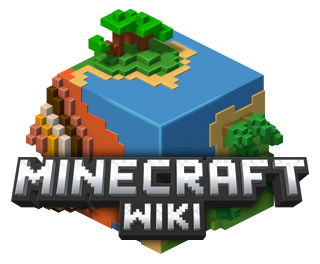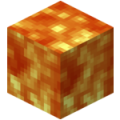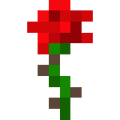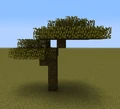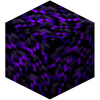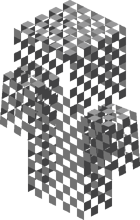cerca de 20% da tradução está concluída
Desde o início do desenvolvimento do Minecraft, houve uma série de recursos que foram removidos do jogo. Esses recursos podem ter sido substituídos ou um desenvolvedor decidiu o oposto do que o recurso se apoiava.
Note que esta página só documenta os recursos do jogo que foram removidos; recursos de um elemento em particular no jogo que foram removidos estão listados em seu histórico dos elementos. Veja recursos não implementados para recursos que ainda estão no jogo atualmente.
Blocos e itens
Sela de Cavalo
Selas de Cavalo eram itens que foram adicionados na snapshot 13w16a durante o desenvolvimento da 1.6.1, juntamente com os cavalos que funcionariam justamente como selas normais, mas para cavalos ao invés de porcos. Era necessário domar um cavalo antes de pôr uma sela de cavalo sobre ele. A sela de cavalo era criada com a seguinte combinação:
{{Fabricação}} em vez disso.A ID de item usada era a 416, que se refere ao suporte de armaduras nas versões atuais.
As selas de cavalos foram removidas mais tarde do jogo na 13w18a e agora selas normais são usadas para ambos os porcos e cavalos.[1][2]
Fonte de água infinita
A fonte de água infinita era um bloco que podia criar água infinita, que poderia se replicar infinitamente para preencher seus volumes. Eles foram adicionados originalmente na Indev (24 de janeiro de 2010) para permitir lagos infinitos em mundos flutuantes.[3]
Esteve disponível com a ID de bloco 52, até ser substituído com o gerador de monstros na Infdev Seecret Friday 2 (25 de junho de 2010).
Fonte de lava infinita
Semelhante à fonte de água infinita, a fonte de lava infinita era um bloco que criava lava infinita que poderia se replicar infinitamente para preencher seus volumes. Também foi adicionado na Indev (24 de janeiro de 2010).
Esteve disponível com a ID de bloco 53, até ser substituído com as escadas de carvalho na Alpha 1.0.0 (28 de junho de 2013).
Fonte de água infinita hackeada para o inventário na Infdev e colocada.
Baú trancado
Baús trancados eram um bloco de Primeiro de Abril. Pressionar usar no baú faria subir uma tela e ao clicar no botão "Go to Store" você seria encaminhado para a "Minecraft Store".
Comparador ativado
Durante o desenvolvimento da 1.5, o comparador foi o primeiro bloco que usou duas ID's de bloco para representar seus estados de ativado e desativado, com os nomes unpowered_comparator e powered_comparator, e ID's numéricos 149 e 150, respectivamente. A partir da 13w05a, o bloco powered_comparator foi tirado de uso no jogo, sendo substituído pelo estado powered (ativado) no bloco unpowered_comparator. Ele ainda pode ser usado, utilizando o comando /setblock, no entanto, ele não funcionará e irá se transformar em um bloco unpowered_comparator.
Poções reversas
Antes da snapshot 15w31a da 1.9, as poções tinham uma forma conhecida como "reversa". No inventário, as poções reversas pareciam idênticas a suas poções-base, bem como a poção mundana e mundana (prolongada), e seus usos também eram idênticos aos de suas poções-base, com a exceção de se transformar em poções reversas em vez de poções-base. A única diferença estava nos valores de dados.
Haviam dois métodos gerais para criar poções reversas, um deles envolve a adição de olhos de aranha fermentados. A reversão, em geral, se referia à mudança, transformar a poção em sua versão original mais fraca (por exemplo, transformar uma poção de veneno (prolongada) em uma poção de dano (reversa) adicionando um olho de aranha fermentado).
- O primeiro método envolvia a adição de pedra luminosa (tipicamente) em uma poção terciária já atualizada. Como essas poções terciárias já foram modificadas com redstone (tipicamente), elas poderiam ser transformadas em sua versão original (reversa) com estados não modificados dependendo de qual modificador foi adicionado anteriormente. Nem todas as poções podem ser revertidas (ou reagidas, nesse caso) quando o pó de pedra luminosa ou pó de redstone era adicionado para atualizar a poção terciária (por exemplo, adicionar redstone em uma poção já "redstone-extended" não vai criar uma nova poção).
- O segundo método envolve a adição de olhas de aranha fermentados, seguidos de pedra luminosa (usualmente). O método dois funcionava com a adição de olho de aranha fermentado em uma poção prolongada positiva (isto é, uma poção prolongada terciária). Na maioria dos casos, isso iria estragar a poção e produzir uma poção negativa de mesma força (nesse caso, prolongada). Então, pedra luminosa (dependendo da receita) era adicionada à poção prolongada negativa. Since these negative tertiary potions (regardless of origin) have already been modified with redstone, the addition of glowstone would revert the potion to a potion of lesser duration.
Um bom exemplo do funcionamento desse processo é a reversão da poção de fraqueza. Uma poção de fraqueza pode ser feita de duas maneiras. O primeiro método é pela adição de olho de aranha fermentado a uma poção mundana (frasco de água + lágrima de Ghast\melancia reluzente/pó do blaze/creme de magma/açúcar/olho de aranha), então adiciona-se redstone para produzir a poção de fraqueza (prolongada). O segundo método é pela adição (novamente) de olho de aranha fermentado ou uma poção de força ou uma poção de regeneração. Poções de força e regeneração, em suas formas base ou prolongada irão produzir poções de fraqueza com igual intensidade (no caso desse exemplo, o olho de aranha foi adicionado à poção de força (prolongada) para produzir a poção de fraqueza (prolongada)).
Agora, deve haver duas Poções de Fraqueza (4:00). O pó de pedra luminosa pode ser adicionado à Poção de Fraqueza (Prolongada) que reverteria a poção em uma Poção de Fraqueza com duração normal (1:30). O ato de reduzir a duração de 4:00 para 1:30 era reversão.
Pedra Luminosa
| Poção | Base | Reagente | Efeito | Duração (em minutos) |
|---|---|---|---|---|
| [[Poção de Resistência ao Fogo| Poção de Resistência ao Fogo (reversa) |
[[Poção de Resistência ao Fogo| Poção de Resistência ao Fogo (prolongada) |
Pó de Pedra Luminosa |
Dá imunidade ao dano causado pelo fogo, lava e variados ataques de Blaze. | 3:00 |
| [[Poção de Visão Noturna| Poção de Visão Noturna (reversa) |
[[Poção de Visão Noturna| Poção de Visão Noturna (prolongada) |
Pó de Pedra Luminosa |
Faz tudo aparentar estar ao nível máximo de iluminação, incluindo áreas subaquáticas. | 3:00 |
| [[Poção da Lentidão| Poção da Lentidão (reversa) |
[[Poção da Lentidão| Poção da Lentidão (prolongada) |
Pó de Pedra Luminosa |
O movimento do jogador é reduzido pelo tempo determinado. | 1:30 |
| [[Poção de Fraqueza| Poção de Fraqueza (reverted) |
[[Poção de Fraqueza| Poção de Fraqueza (extended) |
Pó de Pedra Luminosa |
Reduz o dano todos os ataques de arma branca por 0.5 (0.25 coração). | 1:30 |
| [[Potion of Water Breathing| Potion of Water Breathing (reverted) |
[[Potion of Water Breathing| Potion of Water Breathing (extended) |
[[Glowstone Dust| Glowstone Dust |
Does not deplete the oxygen bar when underwater. | 3:00 |
Redstone
| Potion | Base | Reagent | Effect | Duration (minutes) |
|---|---|---|---|---|
| [[Potion of Healing| Potion of Healing (reverted) |
[[Potion of Healing| Potion of Healing II |
Redstone |
Restores |
Instant |
| [[Potion of Harming| Potion of Harming (reverted) |
[[Potion of Harming| Potion of Harming II |
Redstone |
Inflicts |
Instant |
Fermented Spider Eye
| Potion | Base | Reagent | Effect | Duration (minutes) |
|---|---|---|---|---|
| [[Potion of Harming| Potion of Harming (reverted) |
[[Potion of Healing| Potion of Healing (reverted) or [[Potion of Poison| Potion of Poison (extended) |
[[Fermented Spider Eye| Fermented Spider Eye |
Inflicts |
Instant |
| [[Potion of Slowness| Potion of Slowness (reverted) |
[[Potion of Fire Resistance| Potion of Fire Resistance (reverted) or [[Potion of Swiftness| Potion of Swiftness II |
[[Fermented Spider Eye| Fermented Spider Eye |
Player's movement is slowed to a crouch for the given time. | 1:30 |
| [[Potion of Weakness| Potion of Weakness (reverted) |
[[Potion of Strength| Potion of Strength II or [[Potion of Regeneration| Potion of Regeneration II |
[[Fermented Spider Eye| Fermented Spider Eye |
Reduces all melee attacks by 0.5 damage (0.25 heart). | 1:30 |
Bloco de coral morto genérico
Na snapshot 18w09a, todos os blocos de coral tinham a mesma textura, de cores diferentes. Por causa disso, havia apenas uma variante morta necessária. Na época da snapshot 18w10a, cada cor do bloco de coral tinha sua própria textura exclusiva, mas ainda morria no mesmo bloco de coral morto genérico do instantâneo anterior. O bloco de coral morto genérico foi removido e substituído por variantes mortas para cada cor na snapshot 18w10b.
Rosa
A rosa foi removida na Edição Java 1.7.2 snapshot Edição Java 13w36a, e a rosa foi substituída pela papoula, que tem a mesma função: criar corante vermelho.
Blocos com seis lados
Os seguintes blocos existiram no jogo em algum momento antes de serem eliminados com o advento dos estados do bloco. Se eles retornarão, não se sabe. Curiosamente, outros blocos de seis lados resultantes de circunstâncias semelhantes, como madeira e pedra lisa, não foram removidos, pois se tornaram fabricáveis em atualizações posteriores.
- Hexahedral Piston.png
Um pistão com a textura de cima em todos os seis lados.
- Hexahedral Sticky Piston.png
Um pistão grudento com a textura de cima em todos os seis lados.
Blocos previamente obtidos como itens
The game prevents certain blocks from being obtained through normal gameplay methods, such as crafting, the creative inventory, the pick block key, and the Silk Touch enchantment. It also prevents such blocks from being given through less conventional methods, such as inventory editing, mods, and commands. Until Java Edition 1.7.2 and 1.8, there had been a wide variety of blocks that could be edited into the inventory; over time, however, the game was updated so that these blocks became entirely unavailable, even through inventory editing.
Currently, the game only accepts namespaced IDs (such as minecraft:dirt) in most commands, and uses only these namespaced IDs when assigning blocks to the inventory and save files. The old method of obtaining a block via numerical IDs is no longer an option. In addition, the game automatically removes blocks with illegitimate namespaced IDs from the inventory, so using inventory editors is also no longer an option. Furthermore, certain blocks with both block and item forms, such as minecraft:cake, cannot be obtained in their block form in the inventory; however, since the game has a corresponding item named minecraft:cake, the item form is given instead.
Obtainable until Java Edition 1.7.2
In snapshot 13w37a for Java Edition 1.7.2, the /give command was modified so that it would display the name of the item in chat. Due to this, 26 blocks were made unavailable:
| Block | Namespaced ID | Dec | Hex |
|---|---|---|---|
| Bed | bed | 26 | 1A |
| Piston Head | piston_head | 34 | 22 |
| Piston Extension | piston_extension | 36 | 24 |
| Redstone Wire | redstone_wire | 55 | 37 |
| Wheat | wheat | 59 | 3B |
| Standing Sign | standing_sign | 63 | 3F |
| Oak Door | wooden_door | 64 | 40 |
| Wall Sign | wall_sign | 68 | 44 |
| Iron Door | iron_door | 71 | 47 |
| Lit Redstone Ore | lit_redstone_ore | 74 | 4A |
| Unlit Redstone Torch | unlit_redstone_torch | 75 | 4B |
| Sugar Cane | reeds | 83 | 53 |
| Cake | cake | 92 | 5C |
| Unpowered Repeater | unpowered_repeater | 93 | 5D |
| Powered Repeater | powered_repeater | 94 | 5E |
| Pumpkin Stem | pumpkin_stem | 104 | 68 |
| Melon Stem | melon_stem | 105 | 69 |
| Nether Wart | nether_wart | 115 | 73 |
| Brewing Stand | brewing_stand | 117 | 75 |
| Cauldron | cauldron | 118 | 76 |
| Lit Redstone Lamp | lit_redstone_lamp | 124 | 7C |
| Tripwire | tripwire | 132 | 84 |
| Flower Pot | flower_pot | 140 | 8C |
| Heads | skull | 144 | 90 |
| Unpowered Comparator | unpowered_comparator | 149 | 95 |
| Powered Comparator | powered_comparator | 150 | 96 |
Air item
Air was briefly available as an item in snapshot 13w38b for Java Edition 1.7.2, while Grum had been redefining the code that represented air in-game. This availability only lasted for one snapshot, as it was the focus of several bugs, most notably a bug that made mobs drop air upon death.
| Block | Namespaced ID | Dec | Hex |
|---|---|---|---|
| Air | air | 0 | 00 |
Obtainable until Java Edition 1.8
In snapshot 14w25a for Java Edition 1.8, changes were made to the way the icons of items were rendered, and the way block data was internally represented. Due to this, 12 blocks were made unavailable:
| Block | Namespaced ID | Dec | Hex |
|---|---|---|---|
| Water | flowing_water | 8 | 08 |
| Still Water | water | 9 | 09 |
| Lava | flowing_lava | 10 | 0A |
| Still Lava | lava | 11 | 0B |
| Double Stone Slab | double_stone_slab | 43 | 2B |
| Fire | fire | 51 | 34 |
| Nether Portal | portal | 90 | 5A |
| End Portal | end_portal | 119 | 77 |
| Double Wooden Slab | double_wooden_slab | 125 | 7D |
| Cocoa | cocoa | 127 | 7F |
| Carrots | carrots | 141 | 8D |
| Potatoes | potatoes | 142 | 8E |
Obtainable until Java Edition 1.9
In snapshot 15w49a for Java Edition 1.9, one block was made unavailable:
| Block | Namespaced ID | Dec | Hex |
|---|---|---|---|
| Lit Furnace | lit_furnace | 62 | 3E |
Crafting recipes
Chain armor
Since shortly after their introduction in Indev, and until snapshot 14w25a for Java Edition 1.8, chain armor was craftable using fire. As of that snapshot, fire can no longer exist as an inventory item, even with inventory editing, and the recipe itself was removed from the game's registry of recipes.
{{Fabricação}} em vez disso.Chain armor may still be obtained in other ways. However, the armor was renamed to "Chainmail Armor" in snapshot 18w20a.
Enchanted golden apple
Since their introduction in Java Edition 1.3.1, and until snapshot 15w44a for Java Edition 1.9, enchanted golden apples had the following crafting recipe:
{{Fabricação}} em vez disso.Enchanted golden apples may still be obtained in other ways.
Horse armor
In snapshot 13w16a of Java Edition 1.6.1, a crafting recipe for iron, golden and diamond horse armor was added. In snapshot 13w18a, the crafting recipe was removed; it is unknown why Mojang did this.
{{Fabricação}} em vez disso.Iron, golden and diamond horse armor may still be obtained in other ways.
Generated structures
Brick pyramid
For a brief time, brick pyramids were large structures that generated far away from the spawn point. These pyramids were completely solid; they had no interior rooms. A strange quality about these pyramids is that if one dug under it, a layer of dirt and stone extended under the pyramid. This suggests it spawned right on top of the terrain instead of being a complete pyramid with the bottom underground (such as desert pyramids). Pyramids were removed in later versions of Infdev. The pyramid's base was usually 64 × 64 blocks and was 64 blocks high. Whenever it spawned on top of a large body of water, it would usually add to the amount of bases.
Indev house
The Indev house was a structure available in Indev versions. It generated when the player first started a world.
When the player started a world in the original Indev version, the Indev house would generate as a mossy cobblestone house with two torches, and the player would have flint and steel in their hotbar.
When the player started a world in Indev 0.31 20100124 to the beginning of Infdev, the Indev house would generate as a planks house with two torches and a floor made out of stone.
Obsidian wall
Obsidian walls were used in Infdev to mark the position of the cardinal directions. This created two intersecting planes extending just above the surface of the solid material that surrounds them. This has long since been removed, as it was only found in Infdev 20100227.
Old village
Old villages and old zombie villages could generate in plains, savanna, taiga, ice flats and desert biomes. The type of village, and therefore the style of all structures within it, was determined by the biome where the village well was located. All village biome variants were essentially palette swaps of each other, with the exception of one house in the old ice flats village, which would generate with randomized crop items such as carrots and beetroots. The "old villages" were not known as such until the Village & Pillage update.

Interior of an old village library.
Far Lands
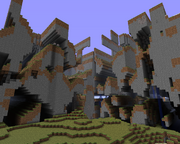
The "corner" of the Far Lands, at ±12,550,821 on both X and Z axes, creating the corner far lands.
The Far Lands was the area that formed the "edge" of the "infinite" map in Java Edition versions prior to Java Edition Beta 1.8. They initiate differently depending on the game's version. In Infdev 20100227, there was a wall of stone that generated 33,554,432 blocks away from spawn. In a later version of Infdev, this changed to where the Far Lands that existed till Java Edition Beta 1.7.3 began at about 12,550,820 blocks from the center of the world, X/Z 0. These Far Lands had two kinds: Edge Far Lands (The Loop) and Corner Far Lands (The Stack); both feature extremely strange terrain. They are known to have several impacts on gameplay, including floating-point precision errors and huge framerate / tickrate drops due to excessive coordinates, and the farther from the center of the world, the worse the effects, until the game freezes and crashes. Beyond X/Z 32,000,000 the chunks are just fake chunks, causing the player to fall through the terrain.
When mods like the "Cubic Chunks" mod came out, a new set of Far Lands called the Sky Far Lands was discovered. When the height limit is removed completely, the Far Lands continue to generate upward until they eventually collide with the Sky Far Lands 25,101,640 blocks upward or to the Void Far Lands 25,101,640 blocks below the world.
In Java Edition Beta 1.7.3 (and probably as far back as Java Edition Alpha v1.2.0), there existed another set of Far Lands called the Farther Lands, which was found very quickly after the discovery of the Far Lands, and generated approximately 1,004,065,600 blocks away from the center of the world. These Farther Lands combined with the previous Far Lands created an even stranger mixture. In this mixture of Far Lands, the terrain was very smooth and hardly changed its shape. Every block would appear 2 dimensional. This was especially noticeable in the Corner Farther Lands.
The Far Lands were removed in Java Edition Beta 1.8, but they still exist in Bedrock Edition.
Monoliths
Monoliths were glitched areas of terrain around Java Edition Alpha v1.1.0 which resembled chunk errors, with the terrain abruptly generating up to the height limit, with natural grass and ore generation. They could theoretically generate infinitely upwards. The area below the monoliths was completely hollow, except for water generating at sea level and a layer of bedrock at the bottom, making the normal terrain seem like inverse monoliths. It is possible to find small crevices in large monoliths, where normal terrain was generated. They tended to generate around flattish terrain. They were caused by an error in the Perlin noise generator.
By setting "Biome Scale Weight" to negative values in customized worlds, they could generate from snapshot 14w17a for Java Edition 1.8 to snapshot 18w05a for Java Edition 1.13, but with the removal of the "Customized" world type altogether in snapshot 18w06a for Java Edition 1.13, this can no longer be recreated.
Trees
Some types of trees can no longer be grown with saplings, and no longer generate naturally in new terrain. They were often the result of using existing textures for new log and leaves types that had not yet been added; new trees subsequently "borrowed" logs and leaves from other trees. For example: acacia trees, when they were first added, used jungle logs and oak leaves.
Glass pillars
Glass pillars were added in Java Edition Beta 1.9 Prerelease 3. They were used to mark the location of strongholds, as the eye of ender was not yet added. They were removed in Java Edition Beta 1.9 Prerelease 4, due to the addition of the eye of ender.
Map settings
Isometric screenshot
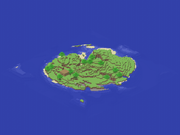
An isometric screenshot.
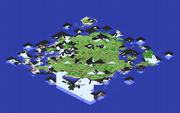
An isometric screenshot displaying the bug of not capturing chunks, which are not in the players FOV.
In the Indev versions of Minecraft, players could take a screenshot of the map from an isometric perspective using F7. When the game captured an isometric image, it would save the current location of all mobs and show any and all alterations to the map the player had made that would be visible from the perspective of the sun (at sunrise). The player would not be visible unless the player was in third-person view before taking the isometric screenshot.
The isometric screenshot would save to their local user folder as "mc_map_####.png" where #### represents the number of the screenshot starting at 0000 up to 9999.
There are some limitations that existed with the screenshots:
- They could only capture the player's sprite when in third-person view.
- Due to a glitch, the screenshot would only render blocks that are in the player's FOV, and everything else will either be black or show underground sections that would have been obstructed.
Indev map shape
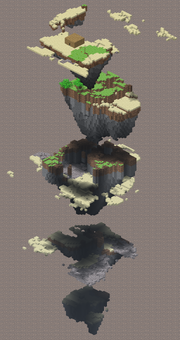
A typical normal, small, floating, deep map in isometric perspective.
The map shape refers to the general dimensions the level generator used to create maps. It was added in Indev 0.31[quando?] and it altered the length, width, and height of the map.
There were three kinds of shapes:
- "Square" was a map of equal length, width and height.
- "Long" was 2 times the length and 1⁄2 times the width of a square map.
- "Deep" was 4 times the height and 1⁄2 times the width and length of a square map.
There were three kinds of sizes:
| Width × Length × Height | Square | Long | Deep |
|---|---|---|---|
| Small | 128 × 128 × 64 | 256 × 64 × 64 | 64 × 64 × 256 |
| Normal | 256 × 256 × 64 | 512 × 128 × 64 | 128 × 128 × 256 |
| Huge | 512 × 512 × 64 | 1028 × 256 × 64 | 256 × 256 × 256 |
Indev map theme
The map theme refers to the general style the level generator used to create maps. It was added in Indev 0.31 on January 7, 2010, and it dramatically affected game mechanics, such as monster spawn zones and boundary liquid. "Paradise" and "Woods" themes were added in Indev 0.31 on February 14, 2010. Themes were removed for in the middle of Infdev and were comparable to biomes in Alpha, Beta, and current Minecraft versions.
Normal

A typical normal, small, island map in isometric perspective.
"Normal" was the default map theme. Above ground, one would find sporadic trees and generally favorable space. The weather was constantly partly cloudy, and the lengths of night and day were equal. Underground, ores of all types could be found and lava was generally found near the bedrock layer.
Boundary liquid: water.
Hell
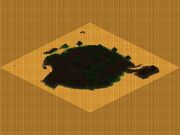
A typical hell, small, island map in isometric perspective.
"Hell" was the second map theme introduced within the map theme feature. Hell featured significantly less lighting during the day, where mobs of all types would spawn at any time. All water was replaced with lava, grass was replaced with dirt and grass would only spawn in place of sand during map generation. Mushrooms were abundant on the surface. Farming worked at a much slower rate (one plant stage per day cycle). This map theme was comparable to the later added Nether.
Boundary liquid: lava.
Paradise
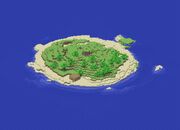
A typical paradise, small, island map in isometric perspective.
The third map theme, "Paradise", was more relaxed than the other themes. It featured larger beaches and plentiful flora compared to the "Normal" theme, and the time is always set to "Noon" (the sun never sets); hostile mobs will only spawn underground. Farming works at a much faster rate (from planting to harvestable in 30–45 minutes).
Boundary liquid: water.
Woods
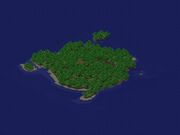
A typical woods, small, island map in isometric perspective.
The fourth map theme, "Woods", was a middle-ground of challenge between "Normal" and "Hell". It provided constant overcast during the day that reduces light, and tree density was higher than the other themes, resulting in the land space becoming smaller. Additionally, mushrooms were spotty throughout the above ground areas.
Boundary liquid: water.
Indev map type
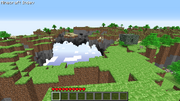
The "Floating" map type.
The map type refers to the general format the level generator used to create maps. Added in Indev 0.31 20100106, it dramatically affected gameplay, such as the availability of water, sand, and gravel. The further the player traveled towards the end of the map, the slower they moved.
There were four kinds of map types:
- "Island" was the default map type featuring minor hills and liquid existing at the borders.
- "Floating" was similar to the floating islands in the "Buffet" world type today — it contained multiple floating islands. Falling from these islands resulted in death as the surface was covered in bedrock. Floating gravel and sand was common, while water was rare.
- "Flat" was similar to the "Superflat" world type today — it featured flat grass with flowers, trees and a starting house.
- "Inland" featured a slightly hilly landscape, which was essentially the "Island" map type with infinite flat land at its borders as opposed to water. Sand and gravel were common.
"Winter Mode" map type

A "Winter Mode" world.
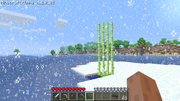
A very rare occurrence: reeds generated in a "Winter Mode" world.
"Winter Mode" was a randomly occurring map type in Alpha. It was added on July 9, 2010 in Java Edition Alpha v1.0.4 and was the first "biome" to appear in Minecraft.
There were a couple of differences compared to normal worlds. First, there was the presence of snowflakes, which fell constantly. There were four different kinds of snowflakes. These snowflakes would create snow tiles on any block that was directly exposed to the sky, provided that it was a solid block. Due to a lack of unfrozen water, reeds were really hard to find. The second element unique to "Winter Mode" was the presence of ice. When a map was generated, most exposed water blocks would be frozen into ice. The water did not freeze completely near gravel beaches. The third element was a decrease in the spawning rate of passive mobs.
"Winter Mode" was removed in Java Edition Alpha v1.2.0 with the addition of proper biomes.
Biomes prior to Java Edition 1.7.2
Versions prior to Java Edition 1.7.2 had many biomes that were later removed.
The following biomes were removed in Java Edition 1.7.2:
- Mountain Edge (still exists in the "Buffet" world type)
- Frozen Ocean (restored in Java Edition 1.13)
Biomes prior to Java Edition Beta 1.8
In Java Edition Beta 1.8, biomes received a major overhaul, removing and changing many of them. Prior to these changes, there were 13 biome types that were much smaller and less distinct.
Gravel roads
Before Java Edition 1.10, villages used gravel to signify roads; however, in Java Edition 1.10, grass paths were added to signify village roads.
Savanna village
Prior to Java Edition 1.10, villages that would generate in savanna biomes used oak logs, oak planks, oak fences and oak stairs. This village type was replaced by villages made out of acacia derived blocks.
"Customized" world type
"Customized" was a world type that gave control over many settings that affected terrain generation, such as ores, sea level, biomes, structures, and many variables that govern the random shape of the terrain. It was introduced in snapshot 14w17a for Java Edition 1.8, and was removed in snapshot 18w06a for Java Edition 1.13.
Mobs
Beast Boy, Black Steve, Steve, and Rana
Beast Boy, Black Steve, Steve, and Rana were human mobs originally used as a test during the Indev phase. They were made by Dock, Minecraft's past artist, and were removed from the game when Dock left the development team in early 2010. These mobs had no animation and glided around in the same pose. Upon death, Beast Boy, Black Steve, and Steve could drop 0–2 feathers, 0–2 sulphur (this item was renamed to "Gunpowder" in Java Edition Beta 1.3) and 0–2 string. Ranas did not drop anything as they were removed when crafting was added. Beast Boy, Black Steve and Steve each had 5![]()
![]()
![]() HP while Rana had 13
HP while Rana had 13![]() × 6.5 HP. Beast Boy is a DC superhero and member of the Teen Titans, and Rana is an original character of Dock. "Rana" means frog in Spanish. When hurt, these mobs made the player's hurt noise. Rana was never in any of the same versions as Beast Boy, Black Steve, or Steve. They were simply human mobs with the M3D models as their entity id was Mob.
× 6.5 HP. Beast Boy is a DC superhero and member of the Teen Titans, and Rana is an original character of Dock. "Rana" means frog in Spanish. When hurt, these mobs made the player's hurt noise. Rana was never in any of the same versions as Beast Boy, Black Steve, or Steve. They were simply human mobs with the M3D models as their entity id was Mob.
Human
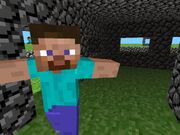
A human before Classic 0.24_SURVIVAL_TEST.
Humans were passive mobs who took the form of clones of the default skin. In Classic, humans could be spawned by pressing G, and would run around aimlessly. From Classic 0.24_SURVIVAL_TEST and onwards, there was another mob called "Monster" which looked like a human, but would attack the player. This "Monster" was the result of trying to spawn the base class for hostile mobs as an actual mob, a similar situation would later occur for humans too. The entity IDs Mob, for humans, and Monster, for "Monster", existed until Java Edition 1.11, in which entity IDs were converted to namespaced IDs.
Zombie drops
Prior to Java Edition Beta 1.8, zombies dropped 0-2 feathers, which were replaced by 0-2 rotten flesh.
Zombie pigman drops
Prior to Java Edition Beta 1.8, zombie pigmen dropped 0-2 cooked porkchops, which were replaced by 0-1 rotten flesh and 0-1 gold nuggets.
Sounds
Game sounds
| Name | Track |
|---|---|
| Arrow Contact | |
| Bow | |
| Door closing | |
| Door opening | |
| Explosion | |
| Flint and Steel | |
| Lava | |
| Leveling up | |
| Old Hurt | |
| Splash | |
| Cow Moo | |
| Cow Hurt |
Player sounds
| Name | Track |
|---|---|
| Fallbig1 | |
| Fallbig2 | |
| Fallsmall |
Unused
These features never had any functionality in-game.
Blocks
Cog
On January 25, 2010, Notch posted a video of gears being placed onto the wall of a cliff.
In Indev on January 25, 2010, the code for gears was added. It could only be obtained by inventory editing and was invisible in the inventory. When edited into the game, gears could only be placed on the side of a block, placing them in a space where two sides are next to each other would cause two gears to appear on both sides. Placed gears were impossible to destroy; any mining directed at a gear phased through to the block behind it, much like water. If the block a gear was on was destroyed, the gear still remained, but oddly, was invisible. The gear still existed in the map and would show up again if a solid block was placed next to them. The same happened when a map editor was used to place a gear in mid-air. Gears could only be removed by letting water flow into them. A gear's sprite consisted of two parts; the center rod and the animated gear.
In Infdev on February 27, 2010, "gear" was renamed to "cog", and later on June 27, 2010, it was removed.
It was available as data value 55, prior to being replaced with redstone in Java Edition Alpha v1.0.1.
Crying obsidian
Crying obsidian was a texture for an abandoned project to implement a spawn point changing obelisk.[4][5][6][7] It was abandoned after the introduction of beds.[8] It would have been crafted with obsidian and lapis lazuli.[9] The texture was added in Java Edition Beta 1.3.
The texture for crying obsidian was removed in Java Edition Beta 1.5.
On February 9, 2012, Jeb was asked "Can you bring back Crying Obsidian or add some new color/texture blocks?" to which he responded, "As soon as I've made preparations for more texture space."[10]
Chairs and other furniture

Two unknown textures, possibly a chair.
In Indev's terrain.png were two textures which might be interpreted as a chair (side and front). The actual purpose of these textures is unknown. The second texture could also be interpreted as the side view of a table. On Notch's blog, The Word of Notch, furniture, and more specifically chairs, are mentioned a few times.[11][12][13][14]
Green shrub
While looking at one of the chests in Java Edition Beta 1.6 Test Build 3, a weird-looking green textured shrub could be seen. It is unknown what this was used for. It most likely resulted from the game attempting to apply biome coloring to the dead bush texture since, at the time, it was used for tall grass with data value 0. This was scrapped for unknown reasons. It was last seen in Java Edition 1.7.
Paeonia
Paeonias were an unimplemented block that was replaced by the two-block-high peonies.
There was only one screenshot of the block released by Jeb.[15] When held in hand, its height was level to the player's shoulder. The texture for this block, flower_paeonia.png, could still be found until it was removed in snapshot 17w47a for Java Edition 1.13.
Items
Armor in Survival Test
In early versions from 0.24_SURVIVAL_TEST through Indev 20100207-2, there was a folder called "armor", which contained two files. One was called chain.png; and the other was called plate.png.
These files were removed in Indev 20100212-1 with the addition of normal armor models.
Plate armor
Plate armor was used in Survival Test for mobs and it gave them no additional defense.
Chain armor
Unlike plate armor, chain armor was impossible to see in-game. It was just an unused texture. It was later removed and replaced with a new model and texture with leggings and boots.
How the plate would look on a player.
A zombie wearing a plate chestplate.
A zombie wearing a full set of plate armor.
A skeleton wearing a plate helmet.
Potions
There were 29 potions without effects that were left behind in Java Edition Beta 1.9 Prerelease 2. All unused potions had effects when implemented, but none afterwards, and appeared to have different colors than the current potions. These potions were later removed in snapshot 15w44b for Java Edition 1.9.
These potions could only be obtained by using the following command: /give @p minecraft:potion 1 <data-value> {CustomPotionEffects:[]}. Adding a multiple of 64 to the value would result in the same potion. As with other potions at the time, adding 16384 to the value would result in a splash version of the given potion.
Quiver

The reformed screenshot.
In Legend of the Chambered (an abandoned RPG that Notch made), there was a quiver item available to be picked up as loot. Notch reused its texture and put it in Minecraft, albeit flipped horizontally. It was added in Indev 0.31 20091231-2.
Although the texture for a quiver has been in the game since Indev, almost nothing is known about it. Jeb has stated that he is not going to add them.[16] Later, during Java Edition 1.9 development, Dinnerbone tweeted a 2×204960 image[17] which can be reformed into a 854×480 Minecraft screenshot, containing the quiver.[18] On June 30, 2015, Dinnerbone posted that he removed them again as arrows in the off-hand feel "more natural".[19]
In Java Edition 1.9, the quiver texture was removed.
Skis

Skis tex ture.
A texture known in the game files as skis.png was added in Java Edition 1.4.6 (around Christmas and New Year). Its texture was added by Dinnerbone as a red herring.[20] The texture was removed in Java Edition 1.6.1.
Mobs / Entities
Pigman
Minecraft user Miclee came up with the idea for pigmen.[21] He was given the Bacon Cape as a reward, but when Notch was asked for personal capes by other users, the Bacon Cape was taken away from Miclee to prevent further commotion.[carece de fontes] Notch mentioned on April 25, 2011 that he might add pigmen as villages' townspeople,[22] although in the Java Edition Beta 1.9 pre-releases, a different villager mob was introduced.
In Java Edition 1.6.2, the texture was removed.
A similar mob called the piglin will be added in Java Edition 1.16.[em breve]
Other
"Play Tutorial Level" button
An unclickable "Play Tutorial Level" button was added to the main menu during Indev. With the addition of texture packs in Java Edition Alpha 1.2.2, the button was removed. No tutorial level had actually existed during that time.
Resources
Brick block variations

Four different brick block textures.
At some point in Classic, there were four similar brick block textures added with slight differences, hinting it might have been planned to add variations in textures.
Mirrored door textures

Mirrored door textures.
In Infdev's terrain.png, two door textures could be found that looked exactly the same except the hinges and the handle were mirrored. In current Minecraft only one of the textures is used and is flipped when the hinges and handle are on the other side. The alternate door was overwritten with the iron door texture in Java Edition Alpha v1.0.1.
Door entity

Door entity texture.
In the Infdev "item" folder (where signs, arrows, and minecarts could be found at the time), a file named door.png could also be found. It was most likely going to be used for the door animation Notch had been wanting to add. The texture was removed in Java Edition 1.6.1.
Fluff.png
Fluff.png.
In Infdev, a texture called Fluff.png was added. It was used as a texture for clouds in Infdev, but was later removed in early Alpha.
Footstep particle
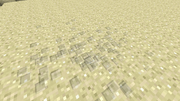
Footstep particles on sand.
The footstep particle was introduced, but never used in-game. It was removed in snapshot 17w47a, as part of The Flattening.
Steve villager hybrid

Steve villager hybrid texture.
After villagers were added, a strange file could be found in the mobs folder (outside of the villager folder) called villager.png. It appeared to be some sort of Steve villager hybrid. The file was removed in Java Edition 1.5 during the texture pack reform. It did not match the villager model. If used for the villager model in a resource pack, it would look glitched.
Char.png
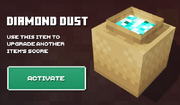
Char.png.
Char.png can be found in Classic 0.27 SURVIVAL TEST's texture files. Steve's hair is on the second layer rather than the first. This was possibly a failed hair test.
Char_2.png
Char_2.png.
Char_2.png can be found in Indev 20100212-1's texture files. This was possibly another failed attempt at testing skins. There are two gold pixels on the top right of Steve's head and two layers of hair.
waterterrain.png
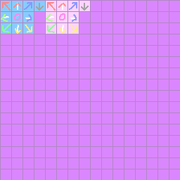
waterterrain.png.
In Infdev, a file similar to terrain.png, referred to as waterterrain.png, could be found. It appeared to be some sort of arrow system, and it is possible this was used to test water animation.
chunkinfo command
From Java Edition 1.8 (snapshot 14w30a) to Java Edition 1.13 (snapshot 17w45a), the file en_us.lang contained translation strings for a /chunkinfo command, which never existed in game. The following keys existed:
commands.chunkinfo.usage=/chunkinfo [<x> <y> <z>] commands.chunkinfo.location=Chunk location: (%s, %s, %s) commands.chunkinfo.noChunk=No chunk found at chunk position %s, %s, %s commands.chunkinfo.notEmpty=Chunk is not empty. commands.chunkinfo.empty=Chunk is empty. commands.chunkinfo.notCompiled=Chunk is not compiled. commands.chunkinfo.compiled=Chunk is compiled. commands.chunkinfo.hasNoRenderableLayers=Chunk has no renderable layers. commands.chunkinfo.hasLayers=Chunk has layers: %s commands.chunkinfo.isEmpty=Chunk has empty layers: %s commands.chunkinfo.vertices=%s layer's buffer contains %s vertices commands.chunkinfo.data=First 64 vertices are: %s
It is unknown if this command was used by Mojang for development or was simply a dropped feature.
Placeholder fire texture
Placeholder graphics for the fire texture were found in terrain.png, which was overwritten in VRAM with the true fire texture. The text read "FIRE TEX! HNST", which means "Fire texture! Honest!". It was replaced by the actual fire animation in Java Edition 1.5. [mais informações necessárias]
Old lava and water textures
Old lava
The old lava and water textures from Alpha could be found in terrain.png. The textures were replaced by different lava and water animations in Java Edition 1.5. [mais informações necessárias]
Village border texture
Village Border
A texture previously used by Mojang to mark the borders of villages could be found in terrain.png. The texture was removed in Java Edition 1.5. [mais informações necessárias]
Duplicate cake texture
A duplicate cake texture could be found in terrain.png. The duplicate texture was removed in Java Edition 1.5. [mais informações necessárias]
Other snow texture?
An unknown texture, though it could be related to the snow weather effect, could be found. The texture was removed in Java Edition 1.5. [mais informações necessárias]
Wax Block
Wax Block was a block texture which was added to the game files in 19w34a, but it was removed in 19w42a.
Crystallized Honey
Crystallized honey was an item texture which was added to the game files in 19w34a, but it was removed in 19w42a.
Other
Calm4.ogg
Calm4.ogg was a music file (alongside the other tracks) that was beta-tested and created by Notch himself. The song is 3 minutes and 13 seconds long. It consists of an upbeat synth, battle-like tune. At 1:36, Notch can be heard saying "Mojang Specifications" in slow-motion.
The track was released around Java Edition Alpha v1.1.1, but in Java Edition Alpha v1.1.2[verificar], this track was omitted from the downloaded game files. Players who had the game while the song file was still included will continue to hear it being played, as the game will play any song in the .minecraft/resources/music folder.
With the introduction of the Java Edition 1.6.1 launcher, playing older versions with the track Calm4.ogg will not allow the track to be heard, since music is downloaded separately from the .jar files.
Player stats
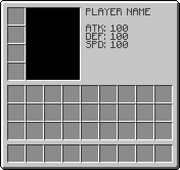
The removed player stats.
In an early Indev version, the player could open the inventory screen and view their name and three stats: "ATK", "DEF", and "SPD". These only existed briefly; when asked, Notch stated he could not remember exactly why they were implemented and subsequently removed, and he assumed they were placeholders for "vague plans".[23]
Inventory changes
An inventory rewrite was originally partially implemented in snapshot 14w07a, but it was reverted before the release of Java Edition 1.8.[mais informações necessárias][24]
Old player death animation
Before Java Edition 1.6.1, on player death, the player would stay standing, leap a little bit, and then disappear. In Java Edition 1.6.1, this was replaced with the player falling and then disappearing.
Notch dropping an apple
Before Java Edition Beta 1.8, a player named Notch would drop an apple upon death.
On-screen version number

Version display in the top left of the screen (Java Edition Beta 1.6 Test Build 3).

All-text version display in the top left of the screen (PC Gamer Demo).
Starting with Classic 0.0.2a, all subsequent versions until RC2 had text displayed in the top left corner of the screen which told what version the player was on. Versions between Java Edition Beta 1.6.4 and Java Edition Beta 1.7.3 did not have this text. From Classic 0.0.2a to Indev 0.31 20100205, only the version number was displayed, but after Indev it switched from being "0.31" to being called "Minecraft Indev" (Indev 20100206), the word "Minecraft" was shown before the version number. In the Alpha development stage, the text read "Minecraft Alpha v#.#.#(_#)." In the Beta development stage, the text read "Minecraft Beta #.#(_#)." This feature was only partially removed, for, among other things, the version number can now be shown by opening the debug screen while in-game. Before Java Edition Alpha v1.2.2, the version number did not display on the main menu screen.
"Unlicensed Copy" message

"Unlicensed Copy" message in the top left of the screen (Java Edition Beta 1.7.3).
In the Beta stage of Minecraft's development, a message reading "Minecraft Beta #.#.#(_0#) Unlicensed Copy :( (Or logged in from another location). Purchase at minecraft.net" was shown. This message can only be seen in versions between Java Edition Beta 1.6 Test Build 3 and Java Edition Beta 1.7.3, as proven by a bytecode editor. The bytecode for the message was removed in Java Edition Beta 1.8.
Spawning nether portals with F4
In Java Edition Alpha v1.2.2a, players had the ability to spawn nether portals by pressing F4. In Java Edition Alpha v1.2.2b, spawning nether portals using F4 was removed.
Time control with F6 and F7
In Java Edition Beta 1.8 Pre-release, as a result of remaining debug code, players had the ability to use F6 and F7 to control in-game time. In Java Edition Beta 1.8 Pre-release 2 ;), the functionality of F6 and F7 was removed.
Achievements
Achievements were available between Java Edition Beta 1.5 and Java Edition 1.12 (snapshot 17w06a). They were ultimately replaced by advancements, though editions other than the Java Edition still have achievements instead.
"Player Activity" button
The "Player Activity" button in "Minecraft Realms" was added in Java Edition 1.5, but it was removed in Java Edition 1.14.4 for unknown reasons. This button was used to show the online activities of players.
Texture pack
Texture packs were added in Java Edition Alpha v1.2.2, and were replaced with resource packs in snapshot 13w24a for Java Edition 1.6.1.
"3D Anaglyph" option

"3D Anaglyph" option before Java Edition 1.13.
"3D Anaglyph" is an option in video settings that applies a red-cyan stereoscopic effect, enabling the use of red-cyan 3D glasses to experience the game in more depth. This option was removed in snapshot 17w43a for Java Edition 1.13.
Void fog

Void fog.

The void, covered in void fog.

A player's view limit would decrease with depth.
In Java Edition Beta 1.8, black void fog and the depthsuspend particle effect were introduced. As the player descended below Y=17 in the Overworld, the void fog and particles would start to appear. As the player traveled deeper, the fog at the edge of the render distance would become closer until the player reached bedrock, where visibility was reduced to just a few blocks, beyond which was complete darkness. The gray void particles appeared below Y=17, as well as in the void.
The void fog was removed in snapshot 14w34c, the main reason being to improve performance.[25] The depthsuspend particle effect was also removed from the void, but stayed in the game until snapshot 17w47a when it was removed as part of The Flattening.
Dispensing command blocks
From snapshot 14w07a for Java Edition 1.8 , dispensers had the ability to place command blocks, when activated. This feature was removed as of Java Edition 1.8.6 to solve a security issue.[26][27]
Mobs running from creepers
In Java Edition 1.8, mobs ran away from creepers that were about to explode. In Java Edition 1.8.1-pre1, this feature was removed because every mob that had the ability to run from a creeper was looking for an exploding creeper every tick, degrading performance.
Water evaporating on magma blocks
In snapshot 16w20a for Java Edition 1.10, water evaporated on top of magma blocks when randomly ticked. From snapshot 18w07a for Java Edition 1.13, whirlpool bubble columns are produced on top of magma blocks instead.
Full hotbar
Before Java Edition 1.4.2, starting a world in Creative mode always started the player with a full hotbar, which included oak saplings, bricks, oak planks, spruce planks, cobblestone, and dirt.
Splashes
Note: When a line of splash text is removed, the line it occupied in splashes.txt is deleted, meaning the line number of all subsequent splashes lowers by one.
Main splashes
| Splash text | Explanation | Version added | Version removed | Pre-removal line number |
|---|---|---|---|---|
| Pre-beta! | The Alpha version of Minecraft. | Indev or earlier | Beta 1.2 | 1 |
| Alpha version! | The Alpha version of Minecraft. | Indev or earlier | Beta 1.2 | 30 |
| 9.95 euro! | The pricing of the Alpha version of Minecraft, which was less than half that of the final price. | Indev or earlier | Beta 1.2 | 48 |
| Half price! | The pricing of the Alpha version of Minecraft, which was less than half that of the final price. | Indev or earlier | Beta 1.2 | 49 |
| Check it out! | Duplicate of "Check it out!" on line 21. | Before Alpha v1.2.0 | Beta 1.8 Pre-release | 47 |
| Notch <3 ez! | Most likely removed because of Notch's departure from Mojang. | Indev | 1.8.5 | 100 |
| SOPA means LOSER in Swedish! | SOPA was a highly controversial anti-piracy bill that made its way through the United States House of Representatives before it was rejected. In Swedish, "sopa" is a noun meaning "trash" or "garbage" and also commonly used as a slang insult.
Prior to Java Edition 1.3, this splash read "SOPA means LOSER in Swedish", without an exclamation point. The specific bill SOPA had not been a current issue for several years, by the time of the splash's removal. However, the splash still exists in Legacy Console Edition. |
1.1 | 1.9 (15w42a) | 304 |
| Better than Prey! | Prey (2006) is a first person shooter that was well received by critics.
Most likely removed to avoid legal issues with ZeniMax Media, because Bethesda Softworks published a game with the same name: Prey (2017). |
Indev | 1.12.1 (17w31a) | 5 |
| Hobo humping slobo babe! | "Hobo Humpin' Slobo Babe" was the critically-acclaimed first single of the band Whale. | Beta 1.8 Pre-release | 1.14 (19w12a) | 259 |
| Made by Notch! | Notch is the creator of Minecraft. | Indev | 1.14 (19w13a) | 9 |
| The Work of Notch! | Notch is the creator of Minecraft. Probably also a reference to The Word of Notch. | Alpha v1.0.0 | 1.14 (19w13a) | 136 |
| 110813! | Notch's and ez's wedding day, August 13, 2011. | Beta 1.8 Pre-release | 1.14 (19w13a) | 233 |
| Woo, minecraftforum! | Referring to Minecraft Forum. Removed shortly after it was announced that the forum would shut down.[28] However, despite the forums instead being sold to a third-party host,[29] this splash remains removed from the latest version. | Alpha v1.0.14 | 1.14.2 Pre-Release 4 | 171 |
Special splashes
| Splash text | Explanation | Date displayed | Version removed |
|---|---|---|---|
| Happy birthday, ez! | Shown on ez's birthday. | November 9 | 1.8.5 |
| Happy birthday, Notch! | Shown on Notch's birthday. | June 1 | 1.8.5 |
"Super Secret Settings" button
The "Super Secret Settings", added in snapshot 13w38a for Java Edition 1.7.2, were removed in snapshot 15w31a for Java Edition 1.9 due to an internal rewrite. It was a button under the options menu that, when pressed, would blare a random game sound with a lower pitch, and activate a shader.
Native Twitch.tv integration
Native Twitch.tv integration was added in snapshot 13w47a for Java Edition 1.7.4, and was removed in snapshot 15w31a for Java Edition 1.9. It integrated Twitch chat into the game.
entity.hanging.place and entity.hanging.pop
entity.hanging.place and entity.hanging.pop were two sound effects added in snapshot 15w49a and removed in the next snapshot, 15w49b. The sound effects were blank audio files and were likely intended as sound effects for the lead.
Old conduit particle
The old conduit particles.
The conduit was added in snapshot 18w15a with particles, but those particles were changed in the next snapshot, 18w16a.
/locate New_Village
There was a locate command called /locate New_Village. This was implemented during the snapshots for Village & Pillage before the village structures from Update Aquatic and prior were removed. Once these "old" villages were officially taken from the game's structure spawn list, /locate New_Village was replaced by /locate Village as the New_Village ID was no longer needed.
Start with 64 fences
In Java Edition Alpha v1.0.17, the player would spawn with 64 fences in their inventory, but in Java Edition Alpha v1.0.17_01 this feature was removed.[verificar]
First-person view pivot
Removed in Java Edition 1.14.4 for performance reasons. [mais informações necessárias]
Placeholder block drops
Survival Test introduced block drops which were mapped as follows:
| Block | Drops |
|---|---|
| Gold Ore | Block of Gold |
| Iron Ore | Block of Iron |
| Coal Ore | Stone Slab |
| Wood | Planks |
Block drops were reworked in Indev.
Minimized textures
In Survival Test, item drops were restricted to the cube shape used for blocks. The projected texture was the same on all faces and the texture scale was closer to those of blocks, making it look cropped.
Tags
The water_hacked and waterlogged tags were added in snapshots 18w07a and 18w07b for Java Edition 1.13 respectively and removed in 18w10c. Before the removal, these tags functioned as follows:
| Tag | Values | Usage |
|---|---|---|
| minecraft:water_hacked | #minecraft:stairs, #minecraft:waterlogged, #minecraft:slabs, minecraft:chest |
|
| minecraft:waterlogged | #minecraft:coral_plants, minecraft:bubble_column, minecraft:kelp, minecraft:kelp_top, minecraft:sea_grass, minecraft:tall_sea_grass |
Java launcher easter eggs
Prior to the release of Launcher 2.1.497x for Java Edition, the launcher contained multiple easter eggs. If the player hovered their cursor over the "Play" button for a few seconds, a random mob would appear in the bottom right corner of the launcher. In the top left corner of the launcher, the player could see a translucent creeper face. There was about a 1⁄11 chance of the creeper face being replaced with a shrugging kaomoji, ¯\_(ツ)_/¯. When the player clicked on either of these, they turned solid white. Clicking them again would return them to their translucent state. In addition, if the player pressed Ctrl+B, the experience orb pickup sound would play.
Old walking animation for players
From pre-Classic to Java Edition Alpha v1.0.9, the walking animation for the player and the human mob was different; the player and the human mob would swing their arms wildly to their sides while walking.
Old walking animation for mobs
In Survival Test, mobs (pigs, sheep, skeletons, zombies, spiders and creepers) had different walking animations.
Creeper melee attack
From Survival Test to Indev, creepers did melee damage to the player. In Indev 0.31 this feature was removed.
References
- ↑ "Oh, yes, one thing that I didn't explicitly say: We have removed the "horse saddle", pigs and horses use the same saddle item now" – @jeb_ no Twitter, April 26, 2013
- ↑ "Twitter sometimes... =) Rehearsal: Saddles not craftable, but found in dungeons. (As before snapshots.) Horses use same saddles as pigs." – @jeb_ no Twitter, April 26, 2013
- ↑ http://notch.tumblr.com/post/333135179/i-should-be-sleeping-but
- ↑ "For texture packers, the grass edge tile has replaced the crying obsidian in the texture file" – @jeb_ no Twitter, April 15, 2011
- ↑ "I don't care. The tile will never be used" – Jeb, April 24, 2011
- ↑ "Yeah it's an abandoned project I had. I left the texture in the file to troll you, naturally ;)" – @jeb_ no Twitter, February 23, 2011
- ↑ "A change-spawn obelisk" – @jeb_ no Twitter, March 30, 2011
- ↑ "It was a set respawn point project, before we added beds" – @jeb_ no Twitter, November 26, 2011
- ↑ "Uhm... obsidian and lapis, somehow... It was silly, really ;)" – @jeb_ no Twitter, November 26, 2011
- ↑ "As soon as I've made preparations for more texture space" – @jeb_ no Twitter, February 9, 2012
- ↑ "Asynchronous saving and loading, and slightly more complex save files" – The Word of Notch, June 3, 2010
- ↑ "Lo and behold, now I need larger blocks" – The Word of Notch, June 3, 2010
- ↑ "I got my Pandora yesterday" – The Word of Notch, June 5, 2010
- ↑ "Finally, an update" – The Word of Notch, June 7, 2010
- ↑ "I've been adding a bunch of new flowers to #minecraft. One of them is the pink Paeonia, as it was the main flower for our wedding" – @jebkhaile, August 16, 2013
- ↑ "No" – Jeb, April 24, 2011
- ↑ "The following picture is meaningless and is probably not even worth your time clicking on it." – @Dinnerbone no Twitter, May 4, 2015
- ↑ "It's not meaningless." – u/FiredPlayer (now deleted) no Reddit, May 4, 2015
- ↑ "I'm removing quivers again. Arrows in off-hand feels more natural." – @Dinnerbone no Twitter, June 30, 2015
- ↑ "Bingo." – @Dinnerbone no Twitter, December 24, 2012
- ↑ "@Micleee thank you!" – @notch no Twitter, October 26, 2010
- ↑ "It's very likely the townspeople will be pigmen =)" – @notch no Twitter, April 25, 2011
- ↑ "I don't even remember putting them in, I assume it was only printed out on that screen as a placeholder for vague plans. I don't think they were ever in the code." – u/xNotch no Reddit, September 7, 2017
- ↑ "We never finished that. We hit a roadblock with the inventory rewrite, and had to shelve it because we couldn't figure out how to proceed nicely." – u/Dinnerbone no Reddit, April 9, 2015
- ↑ "Removed void fog today. Now we don't need to tick air blocks (seriously, WTH?), and honestly, who actually *liked* the void fog?" – @TheMogMiner no Twitter, August 19, 2014
- ↑ "For the security fix in 1.8.6 it was necessary to remove a feature (permanently) that was used by map makers. It wasn't an easy decision." – @SeargeDP no Twitter, May 26, 2015
- ↑ "Unfortunately this feature had to be removed in 1.8.6 for security reasons. It wasn't an easy decision, but there was no other viable option. We usually don't break compatibility and this will be an exception to the rule, hopefully the only one. – Searge, May 26, 2015
- ↑ "Important Minecraft Forum Announcement" – Minecraft Forum, May 21, 2019
- ↑ "A New and Exciting Beginning" – Minecraft Forum, June 12, 2019.
| Versões |
| ||||
|---|---|---|---|---|---|
| Desenvolvimento |
| ||||
| Técnico |
| ||||
| Multijogador | |||||
| Personalização do jogo | |||||
| Edição Java |
| ||||
|---|---|---|---|---|---|
| Edição Bedrock |
| ||||
| Edição Education |
| ||||
| Edição de Console Legado | |||||
| New Nintendo 3DS Edition |
| ||||
